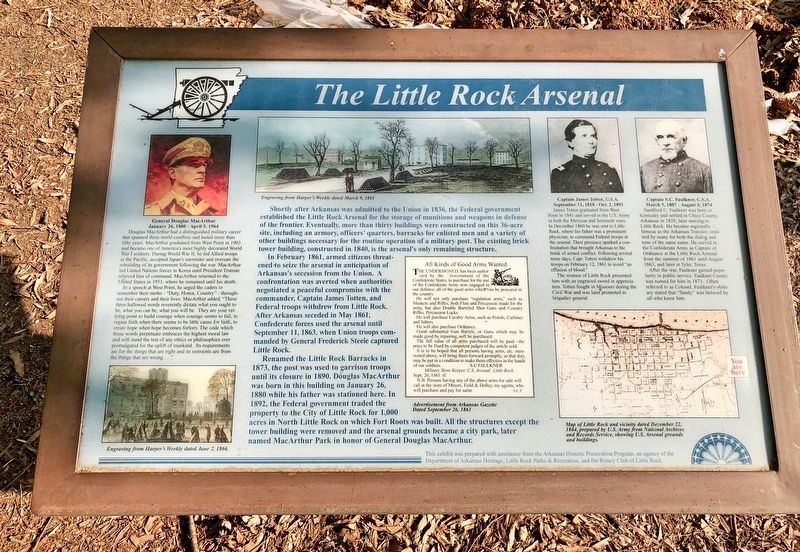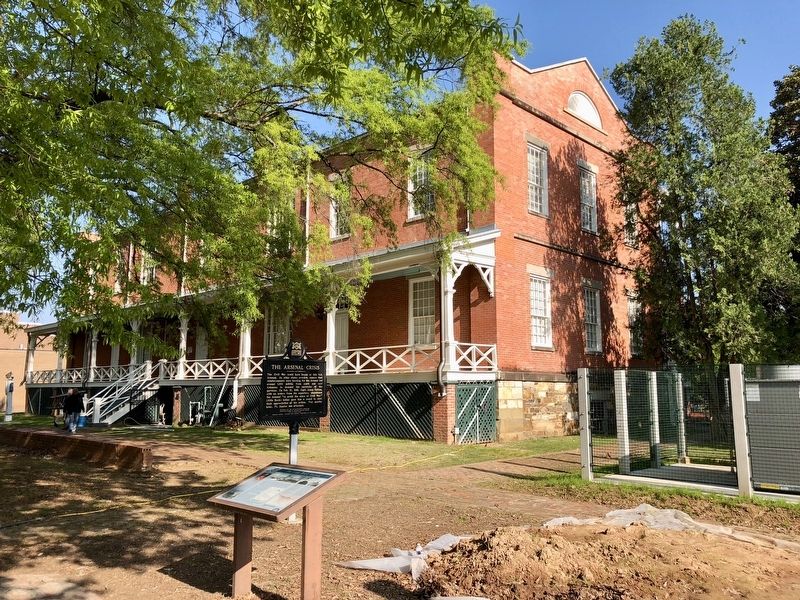Macarthur Park in Little Rock in Pulaski County, Arkansas — The American South (West South Central)
The Little Rock Arsenal
Shortly after Arkansas was admitted to the Union in 1836, the Federal government established the Little Rock Arsenal for the storage of munitions and weapons in defense of the frontier. Eventually, more than thirty buildings were constructed on this 36-acre site, including an armory, officers' quarters, barracks for enlisted men and a variety of other buildings necessary for the routine operation of a military post. The existing brick tower building, constructed in 1840, is the arsenal's only remaining structure.
In February 1861, armed citizens threatened to seize the arsenal in anticipation of Arkansas's secession from the Union. A confrontation was averted when authorities negotiated a peaceful compromise with the commander, Captain James Totten, and Federal troops withdrew from Little Rock. After Arkansas seceded in May 1861, Confederate forces used the arsenal until September 11, 1863, when Union troops commanded by General Frederick Steele captured Little Rock.
Renamed the Little Rock Barracks in 1873, the post was used to garrison troops until its closure in 1890. Douglas MacArthur was born in this building on January 26, 1880 while his father was stationed here. In 1892, the Federal government traded the property to the City of Little Rock for 1,000 acres in North Little Rock on which Fort Roots was built. All the structures except the tower building were removed and the arsenal grounds became a city park, later named MacArthur Park in honor of General Douglas MacArthur.
Insets:
January 26, 1880 - April 5, 1964
Douglas MacArthur had a distinguished military career that spanned three world conflicts and lasted more than fifty years. MacArthur graduated from West Point in 1903 and became one of America's most highly decorated World War I soldiers. During World War II, he led Allied troops n the Pacific, accepted Japan's surrender and oversaw the rebuilding of its government following the war. MacArthur led United Nations forces in Korea until President Truman relieved him of command. MacArthur returned to the United States in 1951, where he remained until his death.
In a speech at West Point, he urged the cadets to remember their motto "Duty, Honor, Country" through out their careers and their lives. MacArthur added, "These three hallowed words reverently dictate what you ought to be, what you can be, what you will be. They are your rallying point to build courage when courage seems to fail, to regain faith when there seems to be little cause for faith, to create hope when hope becomes forlorn. The code which those words perpetuate embraces the highest moral law
promulgated for the uplift of mankind. Its requirements and will stand the test of any ethics or philosophies ever are for the things that are right and its restraints are from the things that are wrong.
September 11, 1818 - Oct. 2, 1891
James Totten graduated from West Point in 1841 and served in the U.S. Army in both the Mexican and Seminole wars. In December 1860 he was sent to Little Rock, where his father was a prominent physician, to command Federal troops at the arsenal. Their presence sparked a confrontation that brought Arkansas to the brink of armed conflict. Following several tense days, Capt. Totten withdrew his troops on February 12, 1861 to avoid "an effusion of blood."
The women of Little Rock presented him with an engraved sword in appreciation. Totten fought in Missouri during the Civil War and was later promoted to brigadier general.
March 5, 1807 - August 4, 1874
After the war, Faulkner gained popularity in public service. Faulkner County was named for him in 1873. Often referred to as Colonel, Faulkner's obituary stated that "Sandy" was beloved by all who knew him.
Captions
Advertisement from Arkansas Gazette, Dated September 26, 1861
Map: Map of Little Rock and vicinity dated December 22, 1864, prepared by U.S. Army from National Archives and Records Service, showing U.S. Arsenal grounds and buildings.
Erected by the Arkansas Historic Preservation Program, an agency of the Department of Arkansas Heritage, Little Rock Parks & Recreation, and the Rotary Club of Little Rock.
Topics and series. This historical marker is listed in these topic lists: Notable Buildings • War, US Civil. In addition, it is included in the Former U.S. Presidents: #33 Harry S. Truman, and the Rotary International series lists. A significant historical date for this entry is January 26, 1880.
Location. 34° 44.292′ N, 92° 15.905′ W. Marker is in Little Rock, Arkansas, in Pulaski County. It is in Macarthur Park. Marker can be reached from East 9th Street. Located behind the MacArthur Museum of Arkansas Military History. Touch for map. Marker is at or near this postal address: 503 East 9th Street, Little Rock AR 72202, United States of America. Touch for directions.
Other nearby markers. At least 8 other markers are within walking distance of this marker. The Arsenal Crisis (here, next to this marker); United Spanish War Veterans Tribute (within shouting distance of this marker); The Mehlburger Markers (within shouting distance of this marker); 206th Coast Artillery (Anti-Aircraft) Memorial (within shouting distance of this marker); The Camden Expedition (within shouting distance of this marker); In Memory of United Spanish War Veterans (within shouting distance of this marker); Roosevelt Visits Little Rock (within shouting distance of this marker); MacArthur Park World War Memorial (within shouting distance of this marker). Touch for a list and map of all markers in Little Rock.
Additional keywords. The Little Rock Arsenal
Credits. This page was last revised on February 10, 2023. It was originally submitted on May 8, 2018, by Mark Hilton of Montgomery, Alabama. This page has been viewed 470 times since then and 23 times this year. Photos: 1, 2. submitted on May 8, 2018, by Mark Hilton of Montgomery, Alabama.

